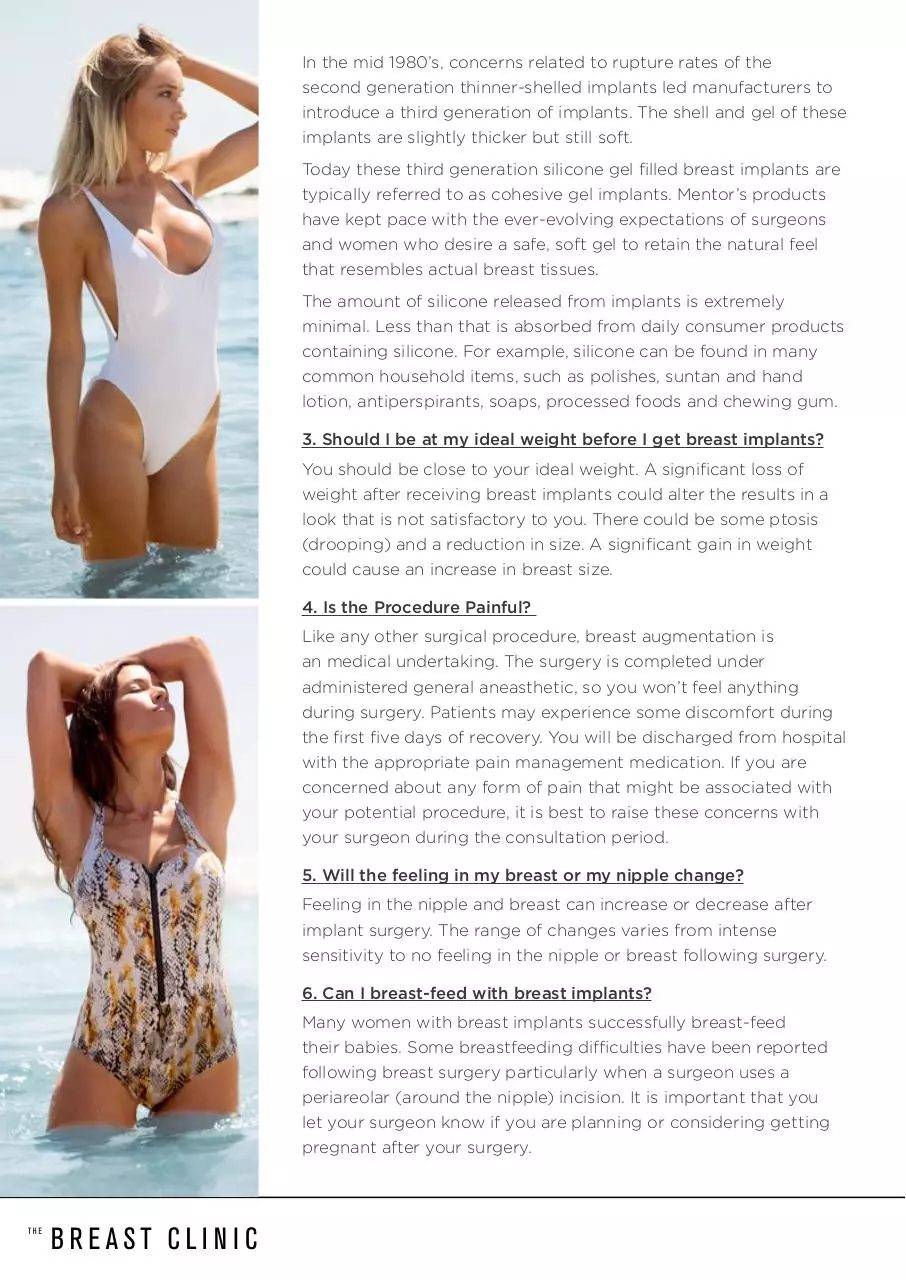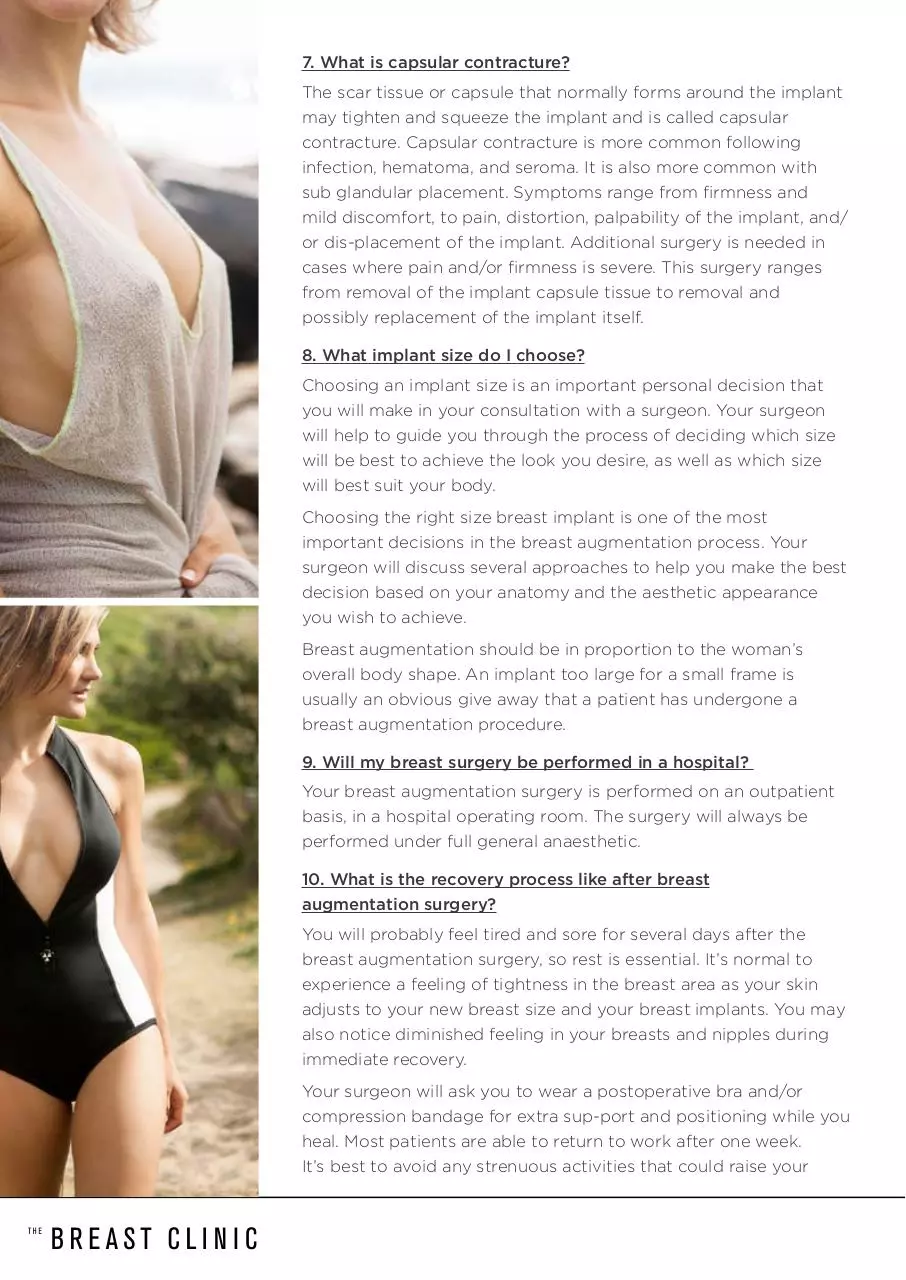FAQ (1) (PDF)
File information
This PDF 1.3 document has been generated by Adobe InDesign CS6 (Macintosh) / Mac OS X 10.11.2 Quartz PDFContext, and has been sent on pdf-archive.com on 31/05/2016 at 16:04, from IP address 86.155.x.x.
The current document download page has been viewed 324 times.
File size: 193.42 KB (4 pages).
Privacy: public file




File preview
MOST FREQUENTLY ASKED QUESTIONS
ABOUT BREAST AUGMENTATION
1. Why is there a ‘cooling-off’ period?
Breast augmentation is a lifetime commitment. It is important that
you are making the right choice for yourself and understand all
the implications of the surgery you are considering. Some women
may need revision surgery later on down the track and need to be
prepared emotionally and financially for this. Breast augmentation
isn’t an urgent procedure. If you are or you are put under pressure
to proceed with surgery right away you should walk away
and look elsewhere.
2. Are Breast Implants Safe?
Silicone gel-filled breast implants have undergone changes over
time to meet increasingly sophisticated consumer expectations.
The first silicone breast implants used thick shells and contained
firm gel. The second generation of implants (introduced in the
late 1970’s) had thinner shells and used less firm gel to address
concerns of patients and surgeons who believed that implants
were too firm, palpable, and visible.
In the mid 1980’s, concerns related to rupture rates of the
second generation thinner-shelled implants led manufacturers to
introduce a third generation of implants. The shell and gel of these
implants are slightly thicker but still soft.
Today these third generation silicone gel filled breast implants are
typically referred to as cohesive gel implants. Mentor’s products
have kept pace with the ever-evolving expectations of surgeons
and women who desire a safe, soft gel to retain the natural feel
that resembles actual breast tissues.
The amount of silicone released from implants is extremely
minimal. Less than that is absorbed from daily consumer products
containing silicone. For example, silicone can be found in many
common household items, such as polishes, suntan and hand
lotion, antiperspirants, soaps, processed foods and chewing gum.
3. Should I be at my ideal weight before I get breast implants?
You should be close to your ideal weight. A significant loss of
weight after receiving breast implants could alter the results in a
look that is not satisfactory to you. There could be some ptosis
(drooping) and a reduction in size. A significant gain in weight
could cause an increase in breast size.
4. Is the Procedure Painful?
Like any other surgical procedure, breast augmentation is
an medical undertaking. The surgery is completed under
administered general aneasthetic, so you won’t feel anything
during surgery. Patients may experience some discomfort during
the first five days of recovery. You will be discharged from hospital
with the appropriate pain management medication. If you are
concerned about any form of pain that might be associated with
your potential procedure, it is best to raise these concerns with
your surgeon during the consultation period.
5. Will the feeling in my breast or my nipple change?
Feeling in the nipple and breast can increase or decrease after
implant surgery. The range of changes varies from intense
sensitivity to no feeling in the nipple or breast following surgery.
6. Can I breast-feed with breast implants?
Many women with breast implants successfully breast-feed
their babies. Some breastfeeding difficulties have been reported
following breast surgery particularly when a surgeon uses a
periareolar (around the nipple) incision. It is important that you
let your surgeon know if you are planning or considering getting
pregnant after your surgery.
7. What is capsular contracture?
The scar tissue or capsule that normally forms around the implant
may tighten and squeeze the implant and is called capsular
contracture. Capsular contracture is more common following
infection, hematoma, and seroma. It is also more common with
sub glandular placement. Symptoms range from firmness and
mild discomfort, to pain, distortion, palpability of the implant, and/
or dis-placement of the implant. Additional surgery is needed in
cases where pain and/or firmness is severe. This surgery ranges
from removal of the implant capsule tissue to removal and
possibly replacement of the implant itself.
8. What implant size do I choose?
Choosing an implant size is an important personal decision that
you will make in your consultation with a surgeon. Your surgeon
will help to guide you through the process of deciding which size
will be best to achieve the look you desire, as well as which size
will best suit your body.
Choosing the right size breast implant is one of the most
important decisions in the breast augmentation process. Your
surgeon will discuss several approaches to help you make the best
decision based on your anatomy and the aesthetic appearance
you wish to achieve.
Breast augmentation should be in proportion to the woman’s
overall body shape. An implant too large for a small frame is
usually an obvious give away that a patient has undergone a
breast augmentation procedure.
9. Will my breast surgery be performed in a hospital?
Your breast augmentation surgery is performed on an outpatient
basis, in a hospital operating room. The surgery will always be
performed under full general anaesthetic.
10. What is the recovery process like after breast
augmentation surgery?
You will probably feel tired and sore for several days after the
breast augmentation surgery, so rest is essential. It’s normal to
experience a feeling of tightness in the breast area as your skin
adjusts to your new breast size and your breast implants. You may
also notice diminished feeling in your breasts and nipples during
immediate recovery.
Your surgeon will ask you to wear a postoperative bra and/or
compression bandage for extra sup-port and positioning while you
heal. Most patients are able to return to work after one week.
It’s best to avoid any strenuous activities that could raise your
pulse and blood pressure, or which require strenuous use of
your arms and chest.
Your surgeon will be able to provide you with more specific
details about the recovery process.
11. Do I have to replace my implants every 10 years?
Many people are under the mistaken impression that breast
implants need to be replaced every ten years. This is simply not
true. If you are not having any problems with your implants, there
is no need to replace them. One of most common reason implants
are replaced is when a woman wants to change her breast size.
12. What other types of breast surgery are available?
đ
Breast Lift and Augmentation - Mastopexty Augmentation
Sometimes breast augmentation on it ’s own isn’t the
right procedure for every women. A common procedure
for patients who have had children, breast fed or lost
a significant amount of weight is a Breast Lift and Augmentation.
đ
Breast Lift - Mastopexy
Women who have adequate breast tissue but feel their breast
may have dropped or sagged due to weight loss or pregnancy
may also consider a Mastopexy or Breast Lift.
A Breast Lift may help restore volume, shape and height.
đ
Breast Reduction
A breast reduction will help to reduce the size, shape and weight
of womens breasts. Breast reduction surgery is particularly
helpful for women that suffer from back pain, soreness from
bra straps, poor posture and overall discomfort. This type of
procedure can be life changing in terms of lifestyle.
đ
Breast Revision
Some women may need to have their implants replaced
at some point in their lives. This can be for a various number
of reasons such as:
− Exchanging breast implants for a different size
− Exchanging breast implants for a different shape
− Correcting asymmetry, contractures or distortions
− Dissatisfied with the outcome from a previous
breast augmentation
đ
Nipple and Areola Correction
The nipple and areola, like the breast, comes in varying shapes
and sizes. It may be asymmetrical, flattened, inverted, or
enlarged. Surgical procedures can easily correct these issues
and create the contour and shape that matches our breasts.
Cosmetic tattooing may also be used.
Download FAQ (1)
FAQ (1).pdf (PDF, 193.42 KB)
Download PDF
Share this file on social networks
Link to this page
Permanent link
Use the permanent link to the download page to share your document on Facebook, Twitter, LinkedIn, or directly with a contact by e-Mail, Messenger, Whatsapp, Line..
Short link
Use the short link to share your document on Twitter or by text message (SMS)
HTML Code
Copy the following HTML code to share your document on a Website or Blog
QR Code to this page

This file has been shared publicly by a user of PDF Archive.
Document ID: 0000378752.